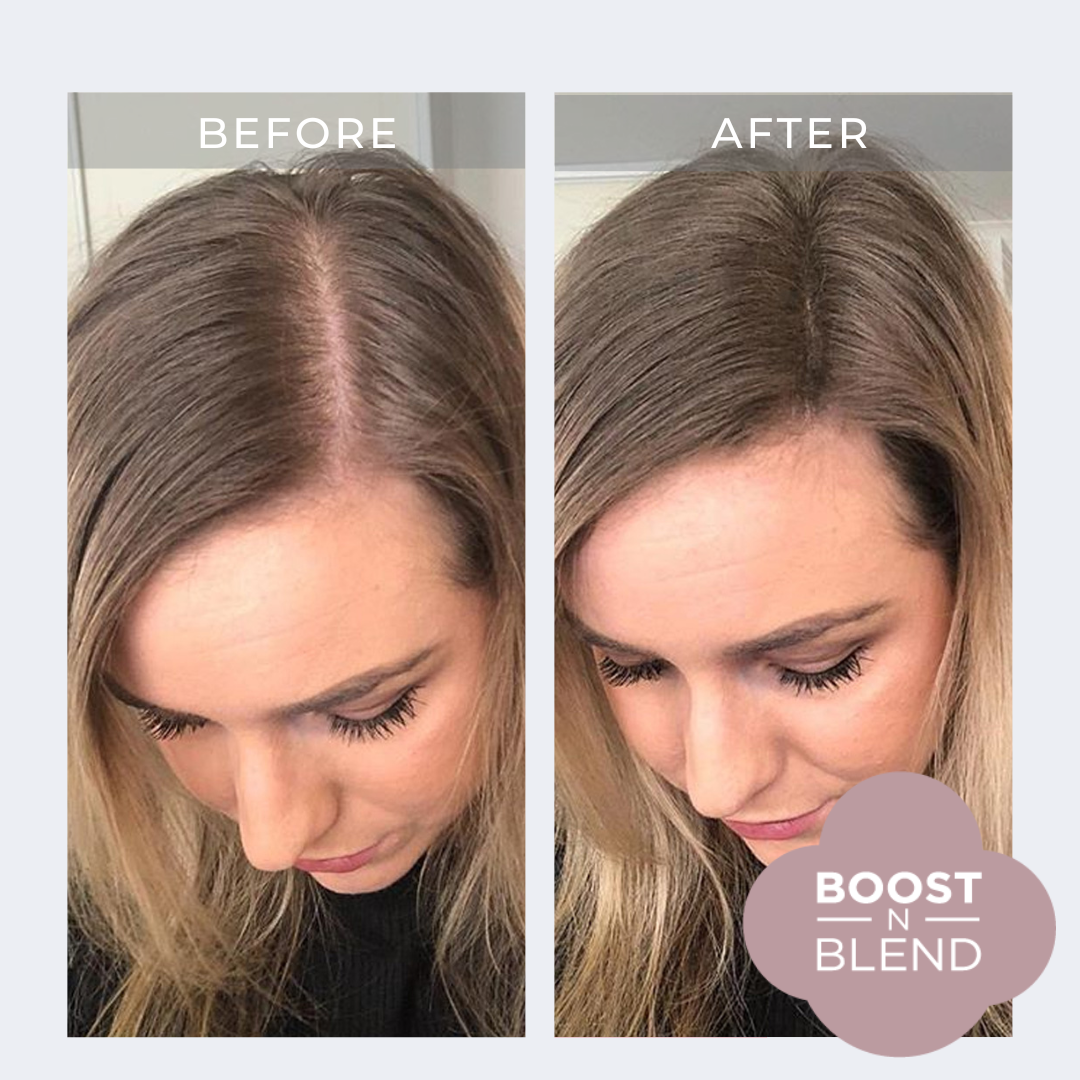
"I have to say, l love your product. I have an 18 month old, and had a fair bit of hair fallout while breastfeeding. Some hair seems to be growing back, but a lot of it isn't. The Boost N Blend™ is great because it's quick and easy. And as a bonus it seems to cover the greys, too. I can't remember how I stumbled on your website, but I'm so glad I did!" - Andrea, VIC
Post pregnancy hair loss is very common. Generalised thinning which results in the unexpected occurrence of visible scalp is very often seen these days among young mums. In fact we see it more now than we did even ten years ago. If you weren't expecting this to happen, you may be worried by the unexpected occurrence of this "male problem".
Here on the Boost N Blend™ website you will find all you need to know to fix it and a little bit of reassurance that all should return to normal - eventually. In the meantime, you can add instant volume to your hair every day or just for that special occasion...
Too busy?
No worries. A quick shake of Boost N Blend™ and you are ready for anything. Check out the examples below which have been achieved in only a few seconds. These tiny micro fibres have been developed by colour consultants to become invisible while clinging to each strand of hair. Made from a natural cotton fibre they allow your hair to continue to recover as your post baby hormones get back to normal. For more information in how they cling, click here.
The science behind post pregnancy hair loss
Normally, your hair cycles through 3 stages: anagen (growing), catagen (resting) and finally telogen (resting/falling). During pregnancy, your higher levels of oestrogen prolong the growth phase which means you have fewer hairs in the resting/falling stage and your hair is thick and lustrous. Once you’ve given birth, these oestrogen levels fall and cause (amongst other things!) a lot of hairs to enter the resting/falling stage. This usually only lasts a few months and most women have their pre-pregnancy hair back within the year.
What can I do about it?
Whilst you can’t stop your hair from falling out, you can make it look less
noticeable. Boost N Blend™ has become many women’s best friend during this period of their lives; many have told us that thanks to Boost N Blend™, no one had even noticed! Read the reviews here.
Boost N Blend™
- Simple – so even a busy mother can shake it on and go
- Instant – shake straight onto dry hair and it’s done. No waiting time.
- Natural – it blends straight in with your existing hair so no one will ever notice.
It's good to know that Boost N Blend™ doesn't stop the natural cycle of hair regrowth. You can use it while you are waiting for the problem to subside.
There is a colour that is right for you. If in doubt as to which colour to choose, select the colour closest to your root colour since that's where you will be applying it.See the full Boost N Blend™ colour range below:

before & after


Dianna


Sara


Celia
More Information
It’s normal to shed up to 100 hairs a day. However, if you notice your hair is no longer as thick as it used to be, or it’s coming out in clumps after brushing, this can be cause for concern.
You may also notice patchy areas of your scalp where there hadn’t been any before. There are all kinds of reasons for hair loss in women, but not to worry – with our natural hair loss concealers, Boost N Blend® can instantly mask the appearance of thinning hair.
Pregnancy is one of the biggest causes of female hair loss, as your body will experience all kinds of hormone changes in this time. During pregnancy, you’ll have higher levels of oestrogen, meaning you’ll have thick, luscious hair. Once you’ve given birth, though, these oestrogen levels fall – and it’s this sudden change in hormones that can cause thinning hair after pregnancy.
Hair loss during pregnancy is incredibly common, and is nothing to be too worried about. After all, your body has just gone through a monumental change, and you’ve produced an amazing little human!
It’s natural that your body will need some time to adjust after undergoing such changes, but the good news is that once your hormone levels begin to stabilise, your hair should grow back and return to its natural state.
As with pregnancy, during menopause your body is going through all kinds of hormonal changes. From the age of forty, our oestrogen levels start to decline, which can lead to fine and thinning hair.
Around the time of menopause, you may also start to experience low thyroid hormones, side effects of medications, or irritable bowel syndrome (IBS) – all of which can contribute to menopause hair loss. Unfortunately, unlike hair loss during pregnancy, thinning hair during menopause is much more complex and harder to grow back. That’s where our natural hair loss concealers and RootZ grey root coverage comes in handy.
Hair loss concealer is designed to mask the signs of thinning hair by providing coverage for patchy areas of your scalp, and making hair strands appear up to 10 times thicker.
Here at Boost N Blend, we’ve created a range of natural hair loss concealers which are designed to hide the signs of female hair loss. Using tiny cotton fibres which cling to your hair, Boost N Blend conceals the appearance of thinning hair by increasing the volume of hair, making each strand up to 10 times thicker.
Typically, this will only last a few months, and you’ll start to see your hair grow back within the year.
Female hair loss is quite common following pregnancy, and hard to avoid. However, by washing with our Boost & Be shampoos and conditioners, you can nurture your hair to be much thicker, stronger and healthier. Using a unique blend of essential oils, Boost & Be restores your hair’s natural oil balance and nurtures each strand from root to tip.
You can reduce the appearance of hair loss after pregnancy by using a Hair Loss Concealer like Boost N Blend. You should also try to eat well and look after yourself.
Your hair will start to grow back after pregnancy, however while waiting for nature to do its thing, you can help things along by using our natural Boost N Blend® hair fibres to cling to each hair shaft and conceal any visible scalp. You might also like to try our Boost & Be shampoo and conditioner, which encourages growth and better hair health.
There are many variables that can contribute to Female Pattern Hair Loss (FPHL), including:
Stress
Pregnancy
Menopause
Hormonal changes, including Polycystic Ovary Syndrome (PCOS)
Telogen Effluvium (TE) – a condition caused by illness, stress or lifestyle changes
Alopecia Areata (AA) – an autoimmune condition
Low iron or B12 deficiencies
Low nutrition through ketogenic or crash diets
Genetics
Change of medication or contraception
During menopause, our oestrogen levels start to drop. As our oestrogen levels drop, the density of our hair starts to decline. There may also be other factors at play, such as low thyroid hormones, irritable bowel syndrome (IBS), inflammation, and medication side-effects – all common during menopause.
While adjusting to the role of motherhood (especially in those first few months), it’s likely that we’ll be sleep-deprived, skipping proper meals, and experiencing nutritional deficiencies while breastfeeding. Adjusting to such a huge lifestyle change is also quite stressful.
All of these things naturally contribute to female hair loss – but never fear! With the Boost N Blend range, you can hide the effects of this condition and regain your confidence while waiting for your hair to grow back (which it will, within the year).
Thinning hair can be caused by a number of things, such as:
Stress: We often joke about stress causing us to pull our hair out, but prolonged periods of stress can actually contribute to hair thinning.
Diet and Nutrition: Having low levels of iron and Vitamin B12 in our diets means there’ll be a deficiency of nutrients to nourish our scalp and follicles. It’s important to keep a healthy, balanced diet to maintain our overall health and wellbeing.
Hormonal Changes: From pregnancy and menopause through to polycystic ovary syndrome and taking the contraceptive pill, hormonal imbalances and changes have a huge effect on our overall health and that of our hair – with lower oestrogen levels meaning less hair growth, volume and density.
Health Conditions & Medications: Illness can lead to female hair loss, as can any underlying health conditions. You may experience Telogen Effluvium (TE) or Alopecia Areata (AA), an autoimmune condition. Medications can also interfere with our body’s natural balance.
Styling or Environmental Damage: Using straighteners, too much product, or sun damage can lead to reduced hair volume and growth.
Shop the range
View allSimply click "Join group" when you arrive at our on the page.




















